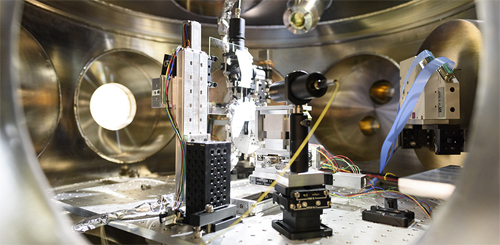
The only way to really learn what happens at the extremes is to go to the extremes. For adventuresome types, such as extreme athletes and explorers, that means scaling forbidding mountains, diving to unimaginable ocean depths, or pushing vehicles to ever greater speeds, at great expense and even greater danger.
Scientists and engineers looking to understand the behavior of a material or chemical compound under extreme conditions don't have to risk life and limb, of course. But the challenges they confront can be no less daunting. What if you want to study the conditions that exist at the center of the Earth, in the atmospheric depths of Jupiter, or even just what's going on at the phase transition when a metal begins to melt? Even the most sophisticated mathematical models can't beat actually seeing it as it happens. Fortunately, scientifically at least, it's not always necessary to go directly to the source. Some extreme conditions can be recreated in the laboratory, where they can be studied in detail and in safety…
To access those kind of extreme conditions, scientists are combining sophisticated synchrotron light facilities with a decades-old experimental physics tool called shock compression. As the term implies, shock compression concerns the response of materials when subjected to high impacts or compression of very short duration…
Anyone who's ever hit their thumb with a hammer, dropped a drinking glass, or set off a firecracker is quite familiar with the effects of such phenomena on the macroscale. But at the microscale, shock compression creates many other important consequences, such as causing temporary or permanent deformations, inducing phase transitions, and greatly increasing temperature, all of which can provide invaluable information both about the structure of a material and how it responds to stress. "If you want the most extreme thermophysical conditions in the laboratory, the only game in town is shockwave compression," says Washington State University condensed matter physicist Yogendra Gupta, principal investigator at the Dynamic Compression Sector (DCS) of the Advanced Photon Source (APS) at Argonne National Laboratory, in the western suburbs of Chicago.
Read the entire SPIE article by Mark Wolverton here.
The Advanced Photon Source is a U.S. Department of Energy (DOE) Office of Science User Facility, operated for the DOE Office of Science by Argonne National Laboratory under Contract No. DE-AC02- 06CH11357.
The U.S. Department of Energy's APS is one of the world’s most productive x-ray light source facilities. Each year, the APS provides high-brightness x-ray beams to a diverse community of more than 5,000 researchers in materials science, chemistry, condensed matter physics, the life and environmental sciences, and applied research. Researchers using the APS produce over 2,000 publications each year detailing impactful discoveries, and solve more vital biological protein structures than users of any other x-ray light source research facility. APS x-rays are ideally suited for explorations of materials and biological structures; elemental distribution; chemical, magnetic, electronic states; and a wide range of technologically important engineering systems from batteries to fuel injector sprays, all of which are the foundations of our nation’s economic, technological, and physical well-being.
Argonne National Laboratory seeks solutions to pressing national problems in science and technology. The nation's first national laboratory, Argonne conducts leading-edge basic and applied scientific research in virtually every scientific discipline. Argonne researchers work closely with researchers from hundreds of companies, universities, and federal, state and municipal agencies to help them solve their specific problems, advance America's scientific leadership and prepare the nation for a better future. With employees from more than 60 nations, Argonne is managed by UChicago Argonne, LLC, for the U.S. DOE Office of Science.
The U.S. Department of Energy's Office of Science is the single largest supporter of basic research in the physical sciences in the United States and is working to address some of the most pressing challenges of our time. For more information, visit the Office of Science website.
